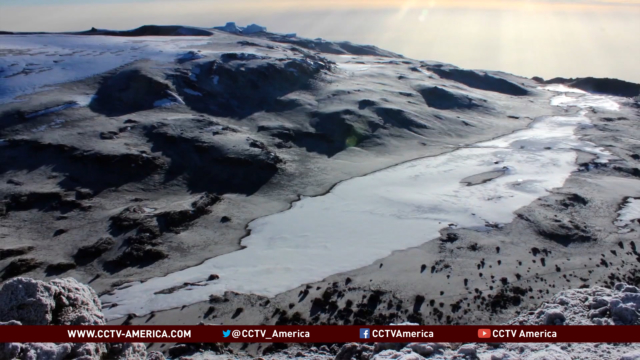It’s one of the most distinctive features of one of the world’s great mountains: the snowcap atop Africa’s Mount Kilimanjaro. The snow of Kilimanjaro is gradually disappearing and experts say it may be completely gone by the end of this century. CCTV’s Hendrik Sybrandy reports.

Climate change: Famous Mount Kilimanjaro snow disappearing
It's one of the most distinctive features of one of the world's great mountains: the snowcap atop Africa's Mount Kilimanjaro. The snow of Kilimanjaro is gradually disappearing and experts say it may be completely gone by the end of this century. CCTV's Hendrik Sybrandy reports.Scientists are divided on why the snow is disappearing. The debate could affect the world’s understanding of climate change.
On a cool late June morning in northern Tanzania, hikers gathered at the Machame Gate, one of the entry points to Mount Kilimanjaro. Their journey to 5,895 meters, or 19,300 feet, wass about to begin.
The trek up Africa’s tallest mountain starts in a rain forest. It ends in a snowfield even though Kilimanjaro is just 320 kilometers from the equator.
It was day two of the climb. The hikers were heading from Machame Camp to Shira Camp. It’s about six miles in all, very steep and pretty arduous. However, the snow of Kilimanjaro that hikers constantly keep in their sights are vanishing.
“Glaciers on the summit of Mt. Kilimanjaro have shrunk dramatically since the mid-19th century and are still continuing to shrink quite rapidly,” said Tad Pfeffer, of the Institute for Arctic and Alpine Research.
Experts disagree on the cause of the glacial retreat. Some argue global warming has triggered snowmelt, including Former U.S. Vice President Al Gore in his award-winning climate-science documentary, “An Inconvenient Truth.”
Meantime, many scientists believe the atmosphere above Kilimanjaro is getting drier, not warmer.
Even in the brutally thin air, it’s clear Kilimanjaro’s snow is far from all gone. This mountain remains an important laboratory for studying glacier loss around the world and for measuring the effect of climate change on atmospheric circulation.
Glaciologist Tad Pfeffer says snow may hang around Kilimanjaro for at least several more decades. Even after that, he predicts Kilimanjaro’s beauty will suffer.
The impacts of climate change are seen not just on snow-covered mountain tops, but also on grass-covered yards. CCTV’s Sean Callebs reports.

What is the impact of human activity on climate change?
The impacts of climate change are seen not just on snow-covered mountain tops, but also on grass-covered yards. CCTV's Sean Callebs reports.Follow Sean Callebs on Twitter @seancctv
At first glance, spray-painting bone-dry lawns a healthy shade of green appears to be the height of suburban vanity. However, it’s actually the product of a prolonged, punishing drought in California. Watering the yard is against the law and rain remains in demand.
The western U.S. is in the grip of a three-year drought. Scientists say climate change is altering weather patterns.
The Mendenhall Ice Caves in Juneau, Alaska are stunning. Tourists come to see them, but the scenry has changed. The warming temperatures finally brought the thin sheet that formed the roof crashing down.
In the U.S., NASA just released a graphic that shows the western ice-sheet of Antarctica has melted “to the point of no return.” This means there is no stopping the melting or retreat of the ice shelf, and it will spawn rising sea levels.
Two years ago, we met Marco Tedesco – a climate change expert who studies melting in Greenland.
A new poll shows a lot of citizens don’t believe human activity is drastically effecting climate change. A study by a British-based firm asked a simple question, “Is the climate change we are seeing largely the result of human activity?”
China led the way, with 93 percent agreeing, while Argentina, Italy, Spain, and Turkey followed. At the bottom, with the lowest of 20 nations surveyed, was the United States with only 54 percent saying “yes” to humans being largely responsible for climate change.
 CGTN America
CGTN America
